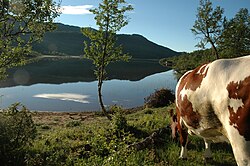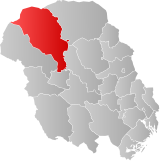
Summary
Rauland is a former municipality in Telemark county, Norway. The 1,830-square-kilometre (710 sq mi) municipality existed from 1860 until its dissolution in 1964. The area is now part of Vinje Municipality. The administrative centre was the village of Raulandsgrend (also known as Rauland) which is where Rauland Church is located. The municipality was a very mountainous, rural area, with about 90% of its area at elevations of 900 metres (3,000 ft) above sea level or higher.[4]
Rauland Municipality
Rauland herad | |
|---|---|
 Rural area in Rauland | |
 Telemark within Norway | |
 Rauland within Telemark | |
| Coordinates: 59°42′59″N 7°59′18″E / 59.71631°N 7.98844°E | |
| Country | Norway |
| County | Telemark |
| District | Vest-Telemark |
| Established | 1860 |
| • Preceded by | Vinje and Lårdal |
| Disestablished | 1 Jan 1964 |
| • Succeeded by | Vinje Municipality |
| Administrative centre | Raulandsgrend |
| Area (upon dissolution) | |
| • Total | 1,830 km2 (710 sq mi) |
| Population (1964) | |
| • Total | 1,656 |
| • Density | 0.90/km2 (2.3/sq mi) |
| Demonym | Raulending[1] |
| Official language | |
| • Norwegian form | Nynorsk |
| Time zone | UTC+01:00 (CET) |
| • Summer (DST) | UTC+02:00 (CEST) |
| ISO 3166 code | NO-0835[3] |
Data from Statistics Norway | |
History edit
In 1860, the northern part of Vinje Municipality (population: 745) was merged with the Øyfjell area in Laardal Municipality (population: 243), together they formed the new municipality of Rauland with a total population of 988. During the 1960s, there were many municipal mergers across Norway due to the work of the Schei Committee. On 1 January 1964, Rauland Municipality (population: 1,656) was merged with Vinje Municipality (population: 2,565) to form a new, larger Vinje Municipality.[5]
Name edit
The municipality (originally the parish) is named after the old Rauland farm (Old Norse: Rauðaland) since the first Rauland Church was built there. The first element is rauði which means "bog iron". The last element is land which means "land" or "district". The many marshlands in the area are filled with bog iron and for centuries its production was an important local resource.[4][6]
Government edit
While it existed, this municipality was responsible for primary education (through 10th grade), outpatient health services, senior citizen services, unemployment and other social services, zoning, economic development, and municipal roads. During its existence, this municipality was governed by a municipal council of elected representatives, which in turn elected a mayor.[7]
Municipal council edit
The municipal council (Herredsstyre) of Rauland was made up of 21 representatives that were elected to four year terms. The tables below show the historical composition of the council by political party.
| Party name (in Nynorsk) | Number of representatives | |
|---|---|---|
| Labour Party (Arbeidarpartiet) | 13 | |
| Centre Party (Senterpartiet) | 4 | |
| Joint List(s) of Non-Socialist Parties (Borgarlege Felleslister) | 4 | |
| Total number of members: | 21 | |
| Party name (in Nynorsk) | Number of representatives | |
|---|---|---|
| Labour Party (Arbeidarpartiet) | 13 | |
| Joint List(s) of Non-Socialist Parties (Borgarlege Felleslister) | 8 | |
| Total number of members: | 21 | |
| Party name (in Nynorsk) | Number of representatives | |
|---|---|---|
| Labour Party (Arbeidarpartiet) | 12 | |
| Joint List(s) of Non-Socialist Parties (Borgarlege Felleslister) | 8 | |
| Total number of members: | 20 | |
| Party name (in Nynorsk) | Number of representatives | |
|---|---|---|
| Labour Party (Arbeidarpartiet) | 8 | |
| Joint list of the Liberal Party (Venstre) and the Radical People's Party (Radikale Folkepartiet) | 1 | |
| Local List(s) (Lokale lister) | 11 | |
| Total number of members: | 20 | |
| Party name (in Nynorsk) | Number of representatives | |
|---|---|---|
| Labour Party (Arbeidarpartiet) | 9 | |
| Joint list of the Liberal Party (Venstre) and the Radical People's Party (Radikale Folkepartiet) | 1 | |
| Local List(s) (Lokale lister) | 10 | |
| Total number of members: | 20 | |
| Party name (in Nynorsk) | Number of representatives | |
|---|---|---|
| Local List(s) (Lokale lister) | 20 | |
| Total number of members: | 20 | |
| Note: Due to the German occupation of Norway during World War II, no elections were held for new municipal councils until after the war ended in 1945. | ||
Notable people edit
- Sveinung Svalastoga (1772–1809), Norwegian rose painter, poet and woodcarver
- Rikard Berge (1881–1969), Norwegian folklorist, museologist, and magazine editor
- Aslaug Vaa (1889–1965), Norwegian poet and playwright
- Olav Aslakson Versto (1892–1977), Norwegian politician for the Norwegian Labour Party
- Dyre Vaa (1903–1980), Norwegian sculptor and painter
See also edit
References edit
- ^ "Navn på steder og personer: Innbyggjarnamn" (in Norwegian). Språkrådet.
- ^ "Forskrift om målvedtak i kommunar og fylkeskommunar" (in Norwegian). Lovdata.no.
- ^ Bolstad, Erik; Thorsnæs, Geir, eds. (26 January 2023). "Kommunenummer". Store norske leksikon (in Norwegian). Kunnskapsforlaget.
- ^ a b Lundbo, Sten; Mæhlum, Lars, eds. (8 November 2021). "Rauland". Store norske leksikon (in Norwegian). Kunnskapsforlaget. Retrieved 1 January 2023.
- ^ Jukvam, Dag (1999). "Historisk oversikt over endringer i kommune- og fylkesinndelingen" (PDF) (in Norwegian). Statistisk sentralbyrå. ISBN 9788253746845.
- ^ Rygh, Oluf (1914). Norske gaardnavne: Bratsbergs amt (in Norwegian) (7 ed.). Kristiania, Norge: W. C. Fabritius & sønners bogtrikkeri. p. 465.
- ^ Hansen, Tore; Vabo, Signy Irene, eds. (20 September 2022). "kommunestyre". Store norske leksikon (in Norwegian). Kunnskapsforlaget. Retrieved 1 January 2023.
- ^ "Kommunevalgene og Ordførervalgene 1959" (PDF) (in Norwegian). Oslo, Norge: Statistisk sentralbyrå. 1960.
- ^ "Kommunevalgene og Ordførervalgene 1955" (PDF) (in Norwegian). Oslo, Norge: Statistisk sentralbyrå. 1957.
- ^ "Kommunevalgene og Ordførervalgene 1951" (PDF) (in Norwegian). Oslo: Statistisk sentralbyrå. 1952.
- ^ "Kommunevalgene og Ordførervalgene 1947" (PDF) (in Norwegian). Oslo: Statistisk sentralbyrå. 1948.
- ^ "Kommunevalgene og Ordførervalgene 1945" (PDF) (in Norwegian). Oslo: Statistisk sentralbyrå. 1947.
- ^ "Kommunevalgene og Ordførervalgene 1937" (PDF) (in Norwegian). Oslo: Statistisk sentralbyrå. 1938.


